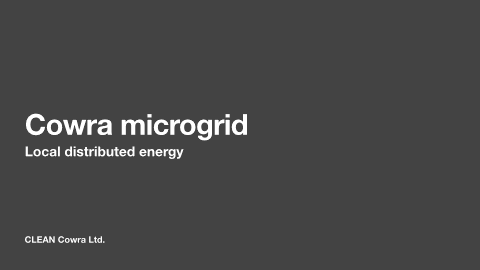MICROGRIDS OFFER BIG BENEFITS FOR REGIONAL BUSINESSES AND COMMUNITIES
/The Cowra Microgrid once complete will present a first-rate example of the many benefits of a local network for regional communities, industries and businesses, as well as establishing the significance of a local network in terms of broader project development. CLEAN Cowra’s Microgrid model is unique because it distributes renewable energy through a shared localised network. To understand the key benefits of the development of the Cowra Microgrid project lets first look at what a microgrid is.
WHAT IS A MICROGRID
A microgrid is a small, local network connected to the national network through a bi-directional “mother” meter. Also known as an embedded network, each user is provided with a sub “child” meter. The Cowra network will predominantly utilise locally- generated distributed resources such as solar, storage and bioenergy and combines those with the national network to provide power to customers on the Microgrid.
COWRA MODEL: BENEFITS AND HOW WILL IT WORK
Located at an industrial site in Cowra, New South Wales, the Cowra Microgrid will connect businesses located at the site to the local grid - a microgrid. Data for usage and peak demand is collected through a shared gate meter, which gives each customer several benefits than if they were to have an individual meter.
Firstly, infrastructure investment is shared. If each customer was to install renewable energy technologies behind their individual meter, those technologies would be sized to the relevant idiosyncratic usage pattern and may find lesser utilisation than if installed at the (Micro)grid level.
Secondly, any local energy generation behind- the-meter can be used by these businesses, reducing consumption from the national network. As the cost of gate meter electricity includes wholesale, retail and network costs, this sees a higher valuation and greater adoption of local distributed energy generation.
To put it simply, the investment in renewable resources is pooled by the participating companies and in return they each get access to a wholesale rather than retail rate on their energy bills. There is also greater liability of energy supply, better infrastructure investment outcomes and increased utilisation. The real clincher is that in adapting their processes to a renewable energy supply they start to shift to net-zero emissions.
WHY A MICROGRID?
The CLEAN Cowra project is a demonstration of new ways businesses can partner to get lower energy costs and greater reliability. Funding from the RRCRF is providing support for a detailed feasibility study to improve the uptake of local electricity generation and establish what infrastructure is necessary to achieve this.
This project provides a demonstration for an innovative and collaborative business model where industry partners can be assured of greater reliability and a more cost- effective delivery of energy, whilst assisting in adapting their processes to net- zero emissions.
CLEAN Cowra MICROGRID AS AN EXAMPLE FOR RURAL COMMUNITIES EVERYWHERE
The CLEAN Cowra Microgrid Model Project will establish a detailed feasibility for the Cowra Microgrid and is seeking to achieve 2 primary objectives.
The value of distributed energy to regional locations. Cowra as a regional agricultural town has abundant resources to produce energy locally. However, this is currently restricted to very larger projects that achieve economies of scale and connect to the transmission network or onsite generation like rooftop solar to reduces (higher) retail energy rates (rather than wholesale).
If electricity is exported into the grid, it is valued at the (low) wholesale electricity price. If electricity is supplied onsite “behind-the-meter”, it is valued at the retail price, as it is reducing consumption from the grid at the retail price. A Microgrid therefore sees an optimal sharing of resources, seeing greater energy cost reduction to these regional industrial businesses and employers.
Additionally, the aggregate demand of 5 diverse customers presents a more steady and homogeneous profile. The larger and steadier demand profile will allow the Microgrid to source grid electricity at more favourable tariffs than the 5 individual less homogeneous demand profiles of the customers would allow them to achieve individually.
The aggregation of the demand profile also presents opportunities for higher “behind-the-meter” generation from distributed energy resources such as baseload-capable combined heat and power (CHP). CLEAN Cowra is concurrently developing a biogas facility as a second stage of the community project and intends to supply CHP based electricity into the Microgrid in the future.

